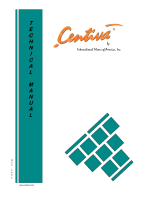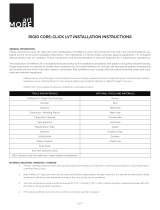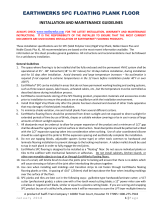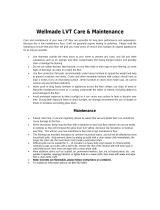
Premium Luxury Vinyl Flooring Installation Instructions for MSI 2MM and 2.5MM Glue-Down Products
General Information
It is important that MSI exible glue-down ooring products maintain proper temperature before, during, and
after installation in order to minimize dimensional changes. The suboor, all ooring material, and the adhesive
must be conditioned at a constant temperature between 65˚F (18˚C) and 85˚F (29˚C) for 48 hours prior to, during,
and 48 hours after installation. Thereafter, maintain a room temperature between 55˚F (13˚C) and 95˚F (35˚C).
When using ooring from two or more cartons, make sure pattern and run numbers found on the carton are the
same. This information is on the outside end of each carton.
Tools and materials
• Universal pressure sensitive LVT adhesive or Multi-use LVT adhesive
• Trowel (1/16” x 1/32” x 1/32” for adhesive)
• 100 pound, 3 section roller
• Chalk Line
• Carpenter square
• Utility Knife
• Cutting board
• Tape measure
• In Situ probes, Moisture Meter, and/or Calcium Chloride Test Kit
Preparing the Area
• Remove all furniture, appliances, and xtures from the room.
• Remove all binding strips or other restrictive molding from doorways, walls, etc.
• Undercut wood door casings where possible so that ooring can be slid under it.
Suboor Preparation
Asbestos Warning
WARNING! DO NOT MECHANICALLY CHIP OR PULVERIZE EXISTING RESILIENT FLOORING, BACKING, LINING
FELT, ASPHALTIC “CUTBACK” ADHESIVES OR OTHER ADHESIVES. Installed resilient oor covering products
and the asphaltic or cutback adhesives used to adhere them may contain either asbestos bers and/or
crystalline silica. The products in this carton DO NOT contain asbestos or crystalline silica. Avoid creating
dust or inhalation of asbestos/crystalline dust as they can cause cancer and respiratory tract hazard.
Smoking by individuals exposed to asbestos bers greatly increases the risk of serious bodily harm. Unless
positively certain that the previously installed product is a non‐asbestos containing material, you must
presume it contains asbestos. Regulations may require that the material be tested to determine asbestos
content and may govern the removal and disposal of material. See current edition of the Resilient Floor
Covering Institute (WWW.RFCI.com) publication “Recommended Work Practices for Removal of Resilient
Page 1
msisurfaces.com

Floor Coverings” for detailed information and instructions on removing all resilient covering structures.
Suboor Preparation
All suboor surfaces must be at, clean, dry, smooth, and free of movement. All surface imperfections should be
lled and sanded with a Portland cement‐based latex patching compound.
Flat within 3/16” in a 10’ radius and or 1/8” in a 6’ radius. Sand high areas or joints. Fill low areas with a high com-
pressive strength Portland base compound.
Completely remove all residual adhesive with an approved method on previously covered concrete oors or
cover them with an Adhesive Encapsulator or cementitious underlayment intended for this purpose. Never use
solvent‐based adhesive removers.
Dry – Select the appropriate moisture indicator test specically designed for use with wood or concrete sub-
oors. Test and record moisture content results. DO NOT INSTALL FLOORING IF MOISTURE TEST RESULTS
EXCEED RECOMMENDED LIMITS. (WWW.RFCI.com)
Concrete Suboors
1.Concrete suboors must be dry, smooth, and free from dust, solvent, paint, wax, grease, asphalt sealingcom-
pounds, and oil or other materials. The surface must be hard and dense, and free from powder or aking. If sur-
face is dusty but meets all other requirements, use a Floor Primer to prepare the surface for adhesive
application.
2.New concrete slabs must be thoroughly dry (at least six weeks) and completely cured. Curing agents, surface-
hardeners and other additives may cause adhesive bonding failure. These should be removed by sanding or
grinding.
3. Moisture arising from new or old concrete can create high levels of moisture vapor emissions, hydrostatic
pressure, and high levels of alkalinity. This combination is highly corrosive and will damage the oor over time. To
avoid this problem, ensure that concrete suboors are constructed according to the American Concrete Institu-
tion’s guidelines (ACI’s 302.2 Guide). To check current conditions, a calcium chloride test (ASTM F1869) and a
RH test using in situ Probes (ASTM F2170) is necessary. If the level of vapor emissions / hydrostatic pressure
exceeds 6lbs and /or 90% RH, you must use a Multi-use LVT adhesive for the install. Responsibility for determin-
ing if the concrete is dry enough for installation of the ooring lies with the owner and installer.
4.If there is old adhesive present from a previous install, you must remove all surface residue. Once you remove-
all surface residue, use an Adhesive Encapsulator to prepare the suboor for the adhesive and a proper bond.
Wood Suboors
NOTE: As with many other interior nish products, modication of existing structural components may be
required for a successful installation.
msisurfaces.com
Page 2

Floor Layout
First, determine the installation direction of the planks. Generally, planks are normally installed running in the long
direction of the main room. Place a mark in the center of the oor at each end of the room and snap a chalk line
between the marks.
To avoid small narrow planks along the walls, divide the distance from the center line to the wall by the plank
width (6”). If the remainder is less than 3 inches, adjust the center line one half width of a plank in either direction.
This will provide a balanced layout with larger cut pieces at the wall.
Finished Flooring Installation
Using the provided trowel adapter, spread the adhesive over one half of the oor up to the center line. Do not
apply excessive adhesive. Allow the adhesive to dry to tack before installing the plank (see adhesive pail label for
clarications). Allow the adhesive to dry completely to tack prior to ooring installation.
Start installing the plank along the center line. Complete each row, including cut pieces at the wall, before pro-
ceeding to the next row. Offset end joints by at least six inches and position planks in a random fashion, work-
ing out of three - four cartons for the best appearance. Position each plank lightly against the previous one by
pressing it rmly into place without sliding it. Remember to avoid small cuts of less than 6 inches at the ends of
each row and place the cut ends towards the wall.
If it is necessary to adjust or remove a plank, use a heat gun to rst warm the plank. Complete the opposite side
of the room in the same fashion as the previous side.
Cutting a plank to t
The last row of planks will need to be cut to t to walls and other vertical surfaces.
Straight Cuts: place a loose plank directly over the top of the last full installed plank, making sure to line up all edges. Using
a plank to measure the distance from the wall to the last installed plank, position the edge against the wall and mark the loose
plank with a pencil where it meets the installed plank at the opposite edge from the wall.
msisurfaces.com
Page 3

CAUTION: Keep ngers away from the knife blade to avoid injury. Install plank with the cut edge toward the wall.
Irregular cuts: Scribe plank to t irregular shapes such as door trims, pipes, etc., and cut with a utility knife.
Immediately after Installation
Roll the entire oor with a 100 pound 3 section roller. Restrict to light trac for the rst 24 hours. Replace the
base moldings and return appliances and furniture to the room by rolling or sliding them over strips of hardboard.
Seal all areas that may be exposed to surface spills (i.e. tubs, toilets, and showers) with silicone caulking.
Plank repairs
• Warm the plank with a heat gun
• Using a sharp utility knife, cut through a corner of the damaged plank taking care not to cut into the sub
oorbelow.
• Lift the end of the plank and continue heating
• As sucient heat is provided the plank will release from the adhesive
• Lift out the entire plank and warm the exposed adhesive Install the new plank
• Set the new plank rmly into place with a hand roller
• The repair is complete Tips & Warnings:
• Sweep regularly, with a soft bristle broom.
• Use felt protectors under heavy pieces of furniture and chairs.
• Use protective mats at all exterior entrances. Do not use mats or area rug cushions constructed of rubber
or PVC. Instead use urethane backed products.
• Spiked heels or shoes in need of repair can severely damage your oor.
• Replace hard plastic, metal casters or wheels on furniture with soft rubber casters or by using a protec
tive matunder the casters.
• The sun’s UV rays can change the color of your oor.
• Keep animal nails trimmed.
• Protect your oor when using a dolly for moving furniture or appliances. Never slide or roll heavy furniture
orappliances across the oor.
*Exterior walk off mats should be routinely maintained to avoid becoming a soil source.
msisurfaces.com
Page 4

WARRANTY COVERAGE
Manufacturing Defect: During the period of the warranty, this product will be free from manufacturing defects.
Wear Resistance: During the period of the warranty, this product’s wear layer will not wear through to the decora-
tive layer under normal use. Excessive wear due to improper maintenance or care is not a defect in the wear layer
or product.
What is NOT Covered by this Warranty (item list is not exhaustive)
• Improper Installation: Material installed that is not installed in accordance with Installation
Instructionsis not a manufacturing related defect. Installer workmanship is not warranted. Labor cost
to repair or replace material installed with visible imperfections Improper maintenance, which results in
loss of gloss level.
• Damage resulting from use of strong detergents, chemicals, paints, dyes, mats, fertilizers, or other
similarmaterials.
• Damage caused by moving appliances or heavy furniture without protecting the oor. (Always protect
oor by using protective covering when moving heavy objects.
• Damage or scratches resulting from accidents, casualty events, abuse or improper usage (includingdam
age from pet claws, teeth, urine etc.). Accidents, abuse and improper usage are dened as, but arenot
limited to damage caused by: casters on furniture, rotating beater bars on vacuum cleaners, burns,cuts,
impact from heavy and sharp objects, narrow or spike heels, cleats, etc., as well as, damageresulting from
unprotected furniture legs.
• Damage caused by leaks from appliances or plumbing.
• Construction damage after installation.
• Installation-related errors or damage including improper conditioning of jobsite and ooring materials.
• Fading, discoloration, or other damage due to excessive temperatures or sunlight. Radiant heat must not
exceed 85 ° F (29°C) and be approved by the manufacturer for the use of their product with resilientvinyl
ooring applications.
• Problems or damage due to excessive moisture or hydrostatic pressure from the sub-oor.
• Discoloration caused by use of latex or rubber-backed oor mats. Note: some synthetic backed carpets
contain latex in the manufacturing process that may discolor vinyl. Always use mats marked as
“nonstaining.”
• Discoloration caused by rubber pads, rubber wheels, rubber tires, rubber rollers, automotive tires, etc.
• Flooring installed on stairs is excluded from warranty coverage.
• Installation of residential product in a commercial environment.
msisurfaces.com
Page 5

If the product fails to perform as stated in the warranty, MSI reserves the right to have the product inspected
by a certied inspector. Should product be determined to be defective, MSI reserves the right to either repair or
replace the defective area with the same color, design and grade product, if available. If product is unavailable or
discontinued, MSI reserves the right to select and supply similar material.
• If repairs or replacement of a section is deemed necessary, all items must be cleared from the
affectedarea subsequent to the original installation. The cost associated with the removal of those items
will notbe credited or reimbursed.
• Product costs will be covered for the length of warranty.
• Labor cost will not be covered.
• Warranty coverage for the replacement oor will be limited to the remaining portion of the original
warranty.
• Any additional claims for loss of prot or incidental losses due to defective product will not beconsidered.
Some examples of incidental damages are: replacement of suboors or underlayment, trimmoldings,
disconnecting / reconnecting appliances, moving of furniture or any other losses deemedincidental by
MSI.
Failure to follow these procedures may result in voiding some or all of the warranty. is limited warranty is not
transferable and extends only to the original end user.
Please note: Some jurisdictions do not allow exclusion or limitation of incidental or consequential damages or limitations
on how long an implied warranty lasts, so the above limitation and exclusion may not apply to you.
is warranty gives you specic rights and you may also have other rights, which vary from state to state.
msisurfaces.com
Page 6
-
 1
1
-
 2
2
-
 3
3
-
 4
4
-
 5
5
-
 6
6
Ask a question and I''ll find the answer in the document
Finding information in a document is now easier with AI
Related papers
Other documents
-
 International Home Products Centiva Floors User manual
International Home Products Centiva Floors User manual
-
Shaw DH83300941 Installation guide
-
Home Decorators Collection STRPRT-MPL Installation guide
-
Ekena Millwork WALP38X18X037PRE User manual
-
SMARTCORE LX55204008 User manual
-
SMARTCORE LX54907010 Installation guide
-
Titan Fitness Rubber Gym Flooring – 15' x 4' x 8mm User manual
-
 Artmore Tile EXT3RD105858 Installation guide
Artmore Tile EXT3RD105858 Installation guide
-
 Earthwerks STP6704 Installation guide
Earthwerks STP6704 Installation guide
-
 Islander 30-2-009 User manual
Islander 30-2-009 User manual









